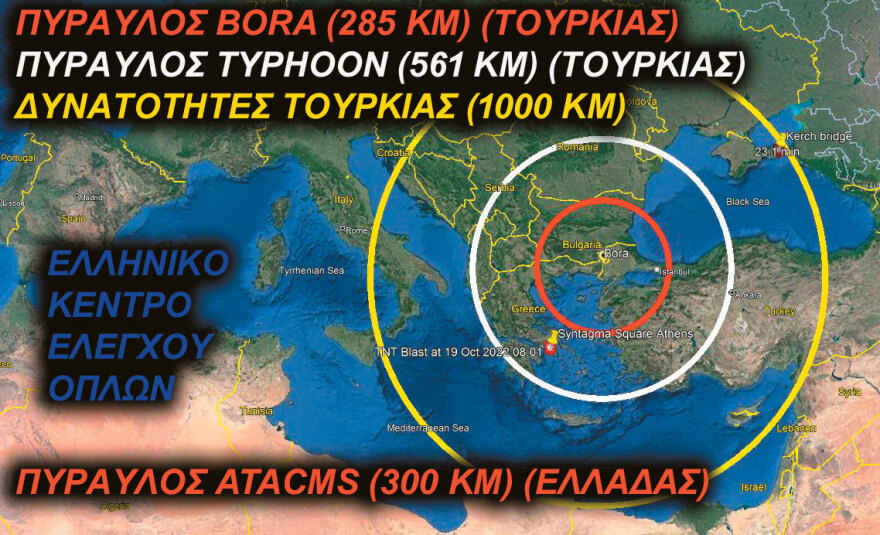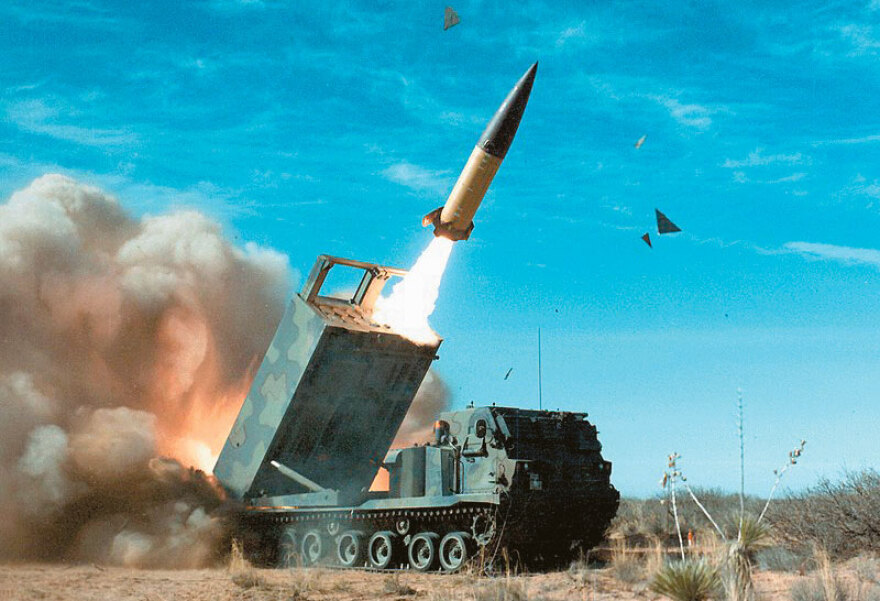Quietly, but also with many reservations as to its true operational capabilities, the Ministry of National Defense is facing the first test launch of the Turkish short-range ballistic missile, Typhoon (Typhoon), which took place last Tuesday, at 7 am, from an air base near the sea port of Resounda. the black. Although Ankara tried to present that the Greek side was surprised by the launch of this particular missile, our country was aware of the efforts made by the Turkish defense industry in recent years in order to increase the range of the Bora (Storm) ballistic missile. From 280 to 600 km. In fact, the new Tayfun missile is an upgrade of the Bora missile, which was operationally included in the Turkish army at the beginning of the year. The Turks added additional fuel tanks to the Bora, reduced the weight of its warhead to expand its range, and called it Typhoon.
According to the Pentagon, the development of the Typhon, like the former Bora, was based on copies of the corresponding Chinese and Pakistani missile systems, with all that this means in terms of their real capabilities, which, based on the first available estimates, are far from similar capabilities of missiles already in the Greek arsenal, such as Scalp missiles with a range of more than 250 km. These are Kacierga Wilderim, and the last addition was Pura, which is said to reach a distance of 280 kilometers. Regardless of the launch of the Tayfun missile and its actual performance, which only the Turks really know, there is still a question whether the Turkish Armed Forces exclusively possess the relevant technical knowledge and to what depth, since the development of its missile program is based on copies and possibly improvements of corresponding systems of Third countries outside the West ”, according to the same circles, stressing that the launch of the missile alone is not a significant event if other criteria related to the characteristics of the missile are not taken into account.

More specifically, the above circles consider that, although the information provided by the Turkish side is scanty, to the extent that doubts were raised about the final results of the launch, the Typhoon is not a weapon system that could pose a real threat to our country, on the one hand, due to the extremely powerful air defense Which the armed forces have along the entire length of the Greek-Turkish border from Evros to the southern Aegean, on the other hand because this particular missile exhibits certain characteristics that make it vulnerable to the Greek anti-missile system. In particular, based on the first estimates that can be made from data that come exclusively from Turkish sources, since the launch of Teyfun has not been confirmed in terms of its scope by any independent organization, the conclusions that emerge are: First, it appears to have a strong footprint, because The Turkish defense industry lacks access to advanced Western technology. As estimated, the Tayfun leaves a large radar footprint, making it easy to detect and vulnerable to means of neutralization.
■ Second, the disproportion between its flight time and the distance it can travel makes it easy to detect and vulnerable.
■ Third, increasing the amount of fuel needed to increase its range affects the amount of explosive it can carry in its warhead, affecting its effectiveness on the target.
■ Fourth, the experience of previous tests of similar missile systems conducted by Turkey shows that it lacks modern navigation systems, which means the inability to accurately determine and neutralize the location of its potential target.
“Given the prevailing weather conditions in which the test was conducted, which were ideal and therefore favorable for the missile, it is still unknown how the missile will behave in adverse or even severe weather conditions. In general, the development and successful use of missile systems may not be a decisive factor for success in war. If one looks at the developments in Ukraine, where despite the widespread use of similar weapons systems by the Russian side, Ukraine is successfully fighting back.Most likely, the Typhon test and its deployment in the current period of time is part of Turkey’s efforts to maintain a climate of tension and intimidation of Greece, while at the same time also aimed at influencing internal public opinion”, concluded the above-mentioned Chambers.
Who is Tayfun?
The Tayfun missile was developed by the Turkish defense company Rocetsan and, according to the Turkish side, traveled 561 kilometers in 458 seconds before falling off the coast of the Sinop port, according to the Turkish side. Although both the manufacturer and the Turkish government officially refrained from giving clear details about the test, Turkish media published several disputed maps, videos and photos, accompanied, among other things, by indicating that Greece is in Turkey’s new range. weapon system. Apart from Greece and depending on its launch point, the Typhon missile can hit Cyprus, Israel, Lebanon, Iraq as far as Baghdad, northern Iran, up to the shores of the Caspian Sea, Syria, all of Armenia and the southern Black Sea coasts. Ukraine and Russia. Typhon belongs to the class of short-range missiles, which have a range of 300-1000 km. Missiles of this type can carry conventional, nuclear, chemical and biological warheads. This projectile is said to have a speed of Mach 3.6.
* Short Range Ballistic Missile (SRBM),
* Medium Range Ballistic Missiles (MRBM),
* Long-Range Ballistic Missile (IRBM),
■ Intercontinental ballistic missile (ICBM),
■ Submarine-launched ballistic missile (SLBM).
Tayfun was developed by the state-owned company Roketsan, which also manufactures the Bora, Yildirim and Kasirgas missile systems that the Turkish Defense Forces have already included in its arsenal. Roketsan, like other Turkish state defense industries, has been under the presidency since 2018, i.e. President Recep Tayyip Erdogan himself. Note that the Yildirim (Lightning) missile has a range of 150-300 km and its design is based on the Chinese B-611 SRBM missile system. Similarly, Kasirgas is the Turkish version of the Chinese T-300 missile system and has a range of 30 to 120 km.

Anti-Ballistic Missile Systems
However, at the same time, the Greek armed forces seem ready to counter Turkey’s attempt to modernize its missile threat against our country, as it has in its arsenal such anti-ballistic missile systems as the Patriot and S-300, as well as a large number of American designed and manufactured ATACMS ballistic missiles, With a range of 165-300 km and an explosive warhead weighing up to 230 kg. According to Mr. Julius, the secret to dealing with this particular threat is the islands of Greece, which are said to have ATACMS short-range missiles on them. He added, “These missiles reach a great depth inside Turkey and are the Greek response to the specific Turkish threat. Besides, Ankara, by increasing the range of its missiles, does not threaten Greece much more than it was until recently, because in fact with 300,000 From the Bora missiles it reached as far as Thessaloniki. But in any case, our country has other weapons to be able to counter the Tefon threat and they are the Patriots and the S-300”, points out the director of the Greek Arms Control Center.
At the same time, Mr. Julius adds that our country, in addition to operational means, also has diplomatic means to pressure Turkey to abandon or limit its missile program, given that there are relevant treaties signed by Ankara since 1999 and provide for sanctions against anyone who violates them. “There is an international treaty called” Missile Technology Control Regime”, signed by Turkey, as well as Greece. According to the specific treaty, no person can build any missile system he wants, since a series of restrictions have been put in place, such as the range not exceeding 300 km, And a warhead that cannot carry more than 500 kilograms of TNT equivalent, such as explosives, etc. This applies to countries that import equipment from abroad”, says Mr. Julius.
“Until last year, Turkey tested this particular missile with a range of 280 km. Moreover, we do not know if the range of the spectrograph is what was provided, since this thing should be certified by independent international organizations. But if the range is That is, the Greek Foreign Ministry should put a lot of pressure on European governments to prove that they did not provide Turkey the technology that was used to develop Tefon.But even if Ankara imported the relevant technology from countries outside Europe, for example Pakistan or China, then again subject to of sanctions”, concluded the director of the Hellenic Center for Arms Control.





More Stories
F-16 crashes in Ukraine – pilot dies due to his own error
Namibia plans to kill more than 700 wild animals to feed starving population
Endurance test for EU-Turkey relations and Ankara with Greece and Cyprus